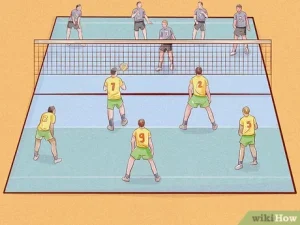Volleyball, a dynamic sport played by millions worldwide, is not just about spiking and diving—it’s a game of strategy, teamwork, and precision. Central to its structure is the scoring system, a nuanced framework that governs the flow of matches and determines the victor. In this guide, we delve deep into the intricacies of volleyball scoring, uncovering its rules, strategies, and evolution.
Understanding the Basics:
At its core, volleyball scoring is relatively straightforward: points are earned when the ball hits the opponent’s court, with each successful rally resulting in a point for the winning team. However, the scoring system is more elaborate than meets the eye.
Rally Scoring vs. Side-Out Scoring:
Traditionally, volleyball matches were played using side-out scoring, where only the serving team could score a point. If the receiving team won the rally, they gained the serve but not a point. However, modern volleyball predominantly employs rally scoring, where a point is awarded on every rally, regardless of which team served. This change has accelerated the pace of the game, making it more exciting for both players and spectators.
Point System:
In most volleyball competitions, matches are typically played as best-of-five sets. To win a set, a team must reach 25 points (with a two-point advantage) first. If the match reaches a fifth set, it is played to 15 points. However, in some variations, like collegiate volleyball, the fifth set is played to 15 points regardless of the previous sets’ length.
Deciding Factors:
If the match reaches a deciding set (often referred to as the fifth set), the first team to reach 15 points with a two-point advantage wins. In the case of a tie at 14-14, play continues until one team gains a two-point lead.
Strategies and Tactics:
Volleyball scoring isn’t just about brute force; it’s a game of strategy and finesse. Teams employ various tactics to gain an edge over their opponents and secure crucial points.
Serving Strategies:
The serve is the only offensive action entirely controlled by one player, making it a critical aspect of the game. Players can employ different types of serves, such as the jump serve, float serve, or topspin serve, to put pressure on the opposing team. Strategic serving aims to disrupt the opponent’s passing rhythm and create scoring opportunities.
Offensive Play:
Effective offensive play revolves around quick transitions from defense to attack. Players utilize tactics like the set and spike, where the setter positions the ball for a teammate to spike it into the opponent’s court. Coordinated attacks and deceptive plays, such as the dump shot, can catch the opposing team off guard and lead to valuable points.
Defensive Strategies:
A solid defense is essential for thwarting the opponent’s offensive efforts and initiating counterattacks. Teams employ techniques like blocking and digging to prevent the ball from hitting the ground on their side of the court. Positioning, timing, and communication are crucial for effective defensive play.
Evolution of Volleyball Scoring:
The scoring system in volleyball has undergone several changes over the years, reflecting the sport’s evolution and efforts to enhance its excitement and competitiveness.
Introduction of Rally Scoring:
The transition from side-out scoring to rally scoring revolutionized the game, making it more fast-paced and spectator-friendly. Rally scoring rewards consistency and punishes mistakes, leading to more dynamic and unpredictable matches.
Adoption of Set Scoring:
In the past, volleyball sets were played to a fixed number of points, typically 15 or 21. However, the adoption of set scoring, where sets are played to 25 points (and 15 in the deciding set), standardized the format across different levels of play and increased the significance of each point.
Volleyball is a dynamic and thrilling sport loved by millions around the world. Beyond its fast-paced action and impressive athleticism, understanding the intricacies of volleyball scoring adds a layer of appreciation to the game. In this comprehensive guide, we’ll dive deep into the scoring system of volleyball, unraveling its rules, nuances, and strategies.
The Basics of Volleyball Scoring
Volleyball scoring revolves around sets and matches, each comprising its own unique set of rules and strategies. Let’s start with the fundamentals:
1.1. Sets:
A volleyball match consists of a series of sets.
In standard play, a set is won by the team that reaches 25 points first, with a minimum two-point advantage. If the score ties at 24-24, play continues until one team gains a two-point lead.
If the match extends to a fifth set (in best-of-five matches), it’s typically played to 15 points, again with a two-point lead requirement.
In some variations, such as high school or recreational leagues, sets may be played to 21 points.
1.2. Matches:
A volleyball match is typically a best-of-five sets competition.
The team that wins three sets first wins the match.
In case of a tie at 2-2 in sets, the fifth set (if played) decides the winner.
Scoring Techniques and Strategies
Beyond the basic scoring rules, volleyball teams employ various techniques and strategies to secure points efficiently:
2.1. Offense:
Scoring points in volleyball often begins with a well-executed offensive play.
Spike: The most common offensive move, where a player jumps and forcefully hits the ball over the net into the opponent’s court.
Tip: A softer, finesse shot where a player lightly taps the ball over the net, often used to exploit gaps in the opponent’s defense.
2.2. Defense:
Blocking: A defensive move where players jump near the net to intercept and deflect the opponent’s spike, aiming to block it from crossing into their own court.
Dig: A defensive play where players use their hands or arms to prevent the ball from touching the ground after an opponent’s attack.
2.3. Serving:
The serve initiates each rally and presents an opportunity to score.
Aces: A serve that lands in the opponent’s court untouched, earning the serving team a point.
Service Strategy: Players may employ various serving techniques, such as float serves or jump serves, to disrupt the opponent’s reception and gain an advantage.
Advanced Scoring Dynamics
As matches progress, teams adapt their strategies to capitalize on their strengths and exploit their opponents’ weaknesses:
3.1. Momentum:
Volleyball is a game of momentum shifts, where scoring streaks can quickly change the course of a match.
Teams strive to maintain momentum by minimizing errors and capitalizing on scoring opportunities.
3.2. Side Out:
In volleyball, possession of the serve is crucial for scoring points.
Side Out refers to a team winning the right to serve after successfully defending against the opponent’s attack.
3.3. Substitutions:
Coaches strategically substitute players to optimize their team’s performance.
Substitutions can inject fresh energy into the game or introduce specialized players for specific roles, such as serving or blocking.
Related Post:
Clash of Titans: France National Football Team vs Gibraltar National Football Team Lineups
Decoding Success: Inside the World of Football Brainiacs
Unleashing Power: The Ultimate Guide to Easton Ghost Softball Bat
Volleyball scoring is a multifaceted aspect of the game, blending simplicity with complexity to create a thrilling and competitive environment. From the basics of rally scoring to advanced strategies and the sport’s evolution, understanding volleyball scoring is essential for players, coaches, and fans alike. As the game continues to evolve, so too will its scoring system, ensuring that volleyball remains a dynamic and captivating sport for generations to come.




